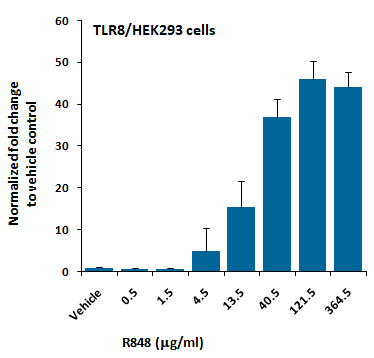|
|
| Gene : |
RELA |
| Gene ID : |
5970 |
| Uniprot ID : |
Q04206
|
| Alternative Name : |
NFKB3, RELA, TF65, Transcription factor p65, p65 |
| Immunogen Information : |
Peptide sequence around phosphorylation site of serine 529 (L-L-S(p)-G-D) derived from Human NFkB-p65. |
NF-kappa-B is a pleiotropic transcription factor which is present in almost all cell types and is involved in many biological processed such as inflammation, immunity, differentiation, cell growth, tumorigenesis and apoptosis. NF-kappa-B is a homo- or heterodimeric complex formed by the Rel-like domain-containing proteins RELA/p65, RELB, NFKB1/p105, NFKB1/p50, REL and NFKB2/p52 and the heterodimeric p65-p50 complex appears to be most abundant one. The dimers bind at kappa-B sites in the DNA of their target genes and the individual dimers have distinct preferences for different kappa-B sites that they can bind with distinguishable affinity and specificity. Different dimer combinations act as transcriptional activators or repressors, respectively. NF-kappa-B is controlled by various mechanisms of post-translational modification and subcellular compartmentalization as well as by interactions with other cofactors or corepressors. NF-kappa-B complexes are held in the cytoplasm in an inactive state complexed with members of the NF-kappa-B inhibitor (I-kappa-B) family. In a conventional activation pathway, I-kappa-B is phosphorylated by I-kappa-B kinases (IKKs) in response to different activators, subsequently degraded thus liberating the active NF-kappa-B complex which translocates to the nucleus. NF-kappa-B heterodimeric p65-p50 and p65-c-Rel complexes are transcriptional activators. The NF-kappa-B p65-p65 complex appears to be involved in invasin-mediated activation of IL-8 expression. The inhibitory effect of I-kappa-B upon NF-kappa-B the cytoplasm is exerted primarily through the interaction with p65. p65 shows a weak DNA-binding site which could contribute directly to DNA binding in the NF-kappa-B complex
Xu C, et al (2005) Oncogene:24(28): 4486-95.
McNulty SE, et al. (2004) Pigment Cell Res Apr; 17(2): 173-80.
Madrid LV,et al. (2001) J Biol Chem: 276(22): 18934-40.
Wang D, et al. (2000) J Biol Chem : 275(42): 32592-7.
Predicted MW: 65kd, Western blotting: 1:500~1:1000, Immunohistochemistry: 1:50~1:100, Immunofluorescence: 1:100~1:200
For Research Use Only. Not for use in diagnostic/therapeutics procedures.
| Subcellular location: |
Nucleus, Cytoplasm |
| Post transnational modification: |
Proteolytically cleaved within a conserved N-terminus region required for base-specific contact with DNA in a CPEN1-mediated manner, and hence inhibits NF-kappa-B transcriptional activity (PubMed:18212740). |
| BioGrid: |
111902. 319 interactions. |
|
There are currently no product reviews
|

























.png)












